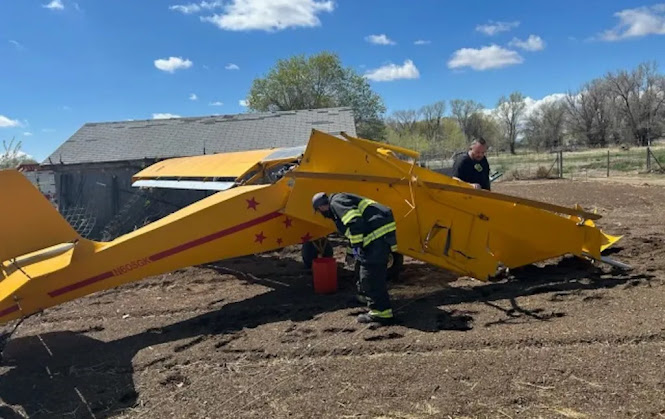- Location: Washington, North Carolina
- Accident Number: ERA24LA351
- Date & Time: August 18, 2024, 21:39 UTC
- Registration: N680SA
- Aircraft: Cessna 680
- Aircraft Damage: Substantial
- Defining Event: Landing gear not configured
- Injuries: 1 Minor, 2 None
- Flight Conducted Under: Part 91: General aviation - Positioning
Thursday, July 10, 2025
Landing gear not configured: Cessna 680 Citation Sovereign, N680SA, accident on August 18, 2024, at Washington-Warren Airport (OCW/KOCW), Washington, North Carolina
Loss of engine power (total): Piper PA-24-250 Comanche, N6430P, accident on June 25, 2023 at Alturas Municipal Airport (AAT/KAAT), Alturas, California
- Location: Alturas, California
- Accident Number: WPR23LA239
- Date & Time: June 25, 2023, 09:00 Local
- Registration: N6430P
- Aircraft: Piper PA-24-250
- Aircraft Damage: Substantial
- Defining Event: Loss of engine power (total)
- Injuries: 1 Minor
- Flight Conducted Under: Part 91: General aviation - Personal
On June 25, 2023, at 0900, Pacific daylight time, a Piper PA-24-250, N6430P, was substantially damaged when it was involved in an accident near Alturas, California. The pilot sustained minor injuries. The airplane was operated as a Title 14 Code of Federal Aviation Regulations Part 91 test flight.
The pilot reported that, shortly after takeoff, the airplane’s engine began to run rough, so he returned to the airport, landed uneventfully, parked the airplane, and deplaned his passengers to conduct another preflight inspection. The pilot sampled the fuel, checked for loose spark plugs, and checked the magnetos. The pilot then decided to do an engine run-up and test flight before departing the area with the passengers. After takeoff, about 100 ft above ground level (agl), the engine began to shake violently, and he initiated a turn back to the airport. The engine lost total power, and the airplane landed hard and came to rest upright in the grass adjacent to the runway, resulting in substantial damage to fuselage, both wings, and the right horizontal stabilizer.
Postaccident examination of the engine established mechanical and valvetrain continuity. When the propeller was rotated, the No. 5 ignition harness top lead did not spark. The right magneto was removed and functionally tested with an intermittent spark. The left magneto was also removed, and spark was obtained on all posts during the functional check. Further testing revealed that the intermittent spark from the right magneto could not be duplicated. Disassembly of right magneto revealed about 1/4 of the teeth were separated from the distributor gear, which would likely result in a partial loss of engine power and a rough running engine. No additional evidence of any preexisting mechanical malfunctions that would have precluded normal operation were observed with either magneto.
- Probable Cause: A loss of engine power due to the failure of the right magneto distributor gear and the pilot’s decision to conduct a test flight with known mechanical issues.
Loss of engine power (partial): Denney Kitfox, N605GK, accident occurred on May 10, 2024, near Powell, Wyoming
- Location: Powell, Wyoming
- Accident Number: WPR24LA148
- Date & Time: May 10, 2024, 10:30 Local
- Registration: N605GK
- Aircraft: KJELSRUD GARY KITFOX
- Aircraft Damage: Substantial
- Defining Event: Loss of engine power (partial)
- Injuries: 1 None
- Flight Conducted Under: Part 91: General aviation - Personal
Fuel exhaustion: Cessna 172K Skyhawk, N84385, accident occurred on June 23, 2023, near Marana, Arizona
- Location: Marana, Arizona
- Accident Number: WPR23LA241
- Date & Time: June 23, 2023, 04:04 Local
- Registration: N84385 Aircraft: Cessna 172K
- Aircraft Damage: Substantial
- Defining Event: Fuel exhaustion
- Injuries: 1 None
- Flight Conducted Under: Part 91: General aviation - Personal
https://data.ntsb.gov/carol-repgen/api/Aviation/ReportMain/GenerateNewestReport/192461/pdf
https://data.ntsb.gov/Docket?ProjectID=192461
On June 23, 2023, about 0404 mountain daylight time, a Cessna 172K, N84385, was substantially damaged when it was involved in an accident near Marana, Arizona. The pilot was not injured. The airplane was operated as a Title 14 Code of Federal Regulations Part 91 personal flight.
The pilot departed on the cross-country flight with an estimated 38 gallons of fuel onboard. While enroute, the pilot deviated from the direct route to his destination, which increased his enroute time and distance. Flight track data revealed that the airplane arrived near the planned fuel stop, but the pilot stated that he diverted to another airport when he could not activate the runway lights at his intended fuel stop. After travelling for about 3 hours, 46 minutes, a total of about 467 miles, and about 5 miles short of the airport intended to be his second fuel stop, the engine lost total power about the time that the pilot stated that the fuel quantity gauges had “dropped all the way to basically nothing.” The pilot reported that there were no mechanical malfunctions or failures that would have precluded normal operation but suspected that the airplane may have developed a fuel leak. Postaccident examination revealed no evidence of a fuel leak. Based on the available information, it is likely that the loss of power was the result of fuel exhaustion. The Owner’s Manual Cruise and Range Performance Chart revealed that with 38 gallons of fuel, the accident flight’s distance and time enroute were within the chart limits; however, the accident flight consisted mostly of low altitude maneuvering flight that were not addressed by the Owner’s Manual.
Field sobriety testing of the pilot was conducted at the scene of the accident, with no determination of impairment being made by law enforcement at that time. Toxicological testing of the pilot’s blood indicated that the pilot likely had used a cannabis product, cocaine, amphetamine, and MDMA. Although his use of these controlled substances conveyed significant risk of impairment, available evidence was insufficient to determine the precise timing of his substance use, specific impairing effects during the accident flight, or whether such effects contributed to the accident.
- Probable Cause: A total loss of engine power due to fuel exhaustion.
















